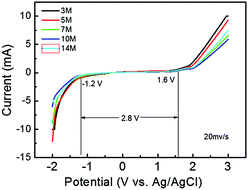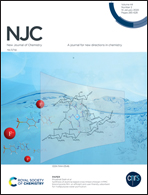A safe propylene carbonate/water hybrid electrolyte for supercapacitors†
Abstract
The electrolyte is one of the most essential components for determining the safety, energy density, and cycling performance of energy storage devices, especially supercapacitors. Conventional high-concentration electrolytes have been widely used in high-performance energy storage devices due to their non-flammability and broad working voltage range. Nevertheless, almost all things have two sides; the low electrical conductivity and high viscosity of conventional high-concentration electrolytes commonly restrict the high rate performance of supercapacitors. Herein, propylene carbonate (PC) is introduced into a conventional high-concentration electrolyte system to form a mixed electrolyte of “LiTFSI–PC/H2O”. Compared to the conventional high-concentration electrolyte, this electrolyte has a significantly lower viscosity and higher conductivity without sacrificing the working potential window. The supercapacitor assembled with the 7 M LiTFSI–PC/H2O electrolyte remained at 15 F g−1 after cycling for 10 000 cycles at a current density of 1 A g−1, and the coulombic efficiency was still close to 100%. At the same time, this novel LiTFSI–PC/H2O hybrid electrolyte also reduces costs and improves safety.



 Please wait while we load your content...
Please wait while we load your content...